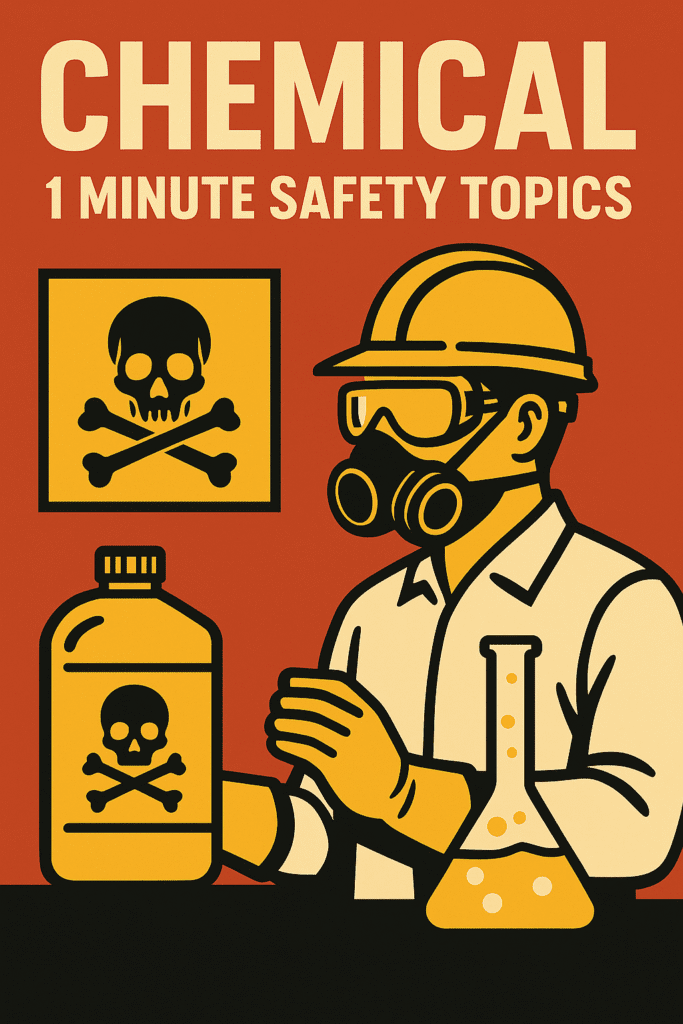
Chemical 1 Minute Safety Topics
Chemicals are part of nearly every workplace—whether in laboratories, factories, construction sites, or even offices. While many chemicals are safe when handled properly, mishandling can cause burns, poisonings, explosions, or long-term health effects. The problem? Workers often become too comfortable around chemicals and forget the risks.
This is why 1-minute chemical safety talks are so powerful. In just 60 seconds, you can remind workers of the most important precautions, refresh their awareness, and reduce the chances of accidents.
What Are 1-Minute Safety Topics?
A 1-minute safety topic is a short, focused message covering a single point about safety. For chemical hazards, these talks help workers remember:
- The correct way to handle substances
- How to protect themselves with PPE
- What to do in case of spills or exposure
Why Chemical Safety Is Critical
Chemical incidents can have immediate and long-term effects:
- Immediate dangers – burns, poisoning, explosions, fires.
- Chronic effects – cancer, respiratory diseases, skin disorders.
- Environmental harm – pollution and contamination.
Global regulations like OSHA’s Hazard Communication Standard (HCS) and international standards (GHS, REACH) exist because of these risks.
Benefits of 1-Minute Chemical Safety Talks
- Keep chemical hazards fresh in workers’ minds.
- Reinforce PPE and safe handling practices.
- Encourage reporting of unsafe storage or spills.
- Build a stronger safety culture around hazardous substances.
Top 10 Chemical 1-Minute Safety Topics
Here are practical topics you can rotate daily:
Topic 1: Proper Labeling of Chemicals
All containers must have labels showing chemical name, hazards, and handling instructions.
Message: “If it’s not labeled, don’t use it.”
Topic 2: Reading Safety Data Sheets (SDS)
Always check the SDS before working with a new chemical. It tells you hazards, PPE, and emergency actions.
Topic 3: Using PPE
Wear the correct gloves, goggles, aprons, and respirators as required. One-size-fits-all doesn’t apply to chemical safety.
Topic 4: Safe Storage of Chemicals
Keep incompatible chemicals separate—like acids away from bases, or oxidizers away from flammables.
Topic 5: Ventilation and Fume Hoods
Never handle volatile or toxic chemicals in unventilated areas.
Topic 6: Spill Prevention and Response
Know where spill kits are located and how to use them.
Quick tip: “A spill ignored is an accident waiting to happen.”
Topic 7: First Aid for Chemical Exposure
Remind workers how to use eye wash stations and emergency showers. Seconds count.
Topic 8: No Eating or Drinking in Chemical Areas
Chemicals can contaminate food and drinks, leading to ingestion.
Topic 9: Waste Disposal
Never pour chemicals down the drain unless specifically allowed. Follow proper disposal procedures.
Topic 10: Emergency Preparedness
Workers should know alarms, evacuation routes, and whom to contact during a chemical incident.
How to Deliver Chemical Safety Talks Effectively
- Keep it short and focused—don’t overload with too much science.
- Use real-world examples (e.g., past incidents or near misses).
- Engage workers with quick questions like: “What’s our spill kit location?”
Mistakes to Avoid
- Using too much technical jargon.
- Ignoring PPE reminders because “everyone already knows.”
- Skipping talks because chemicals are “routine.”
Conclusion
Chemical safety is about consistency. A 1-minute safety talk may seem small, but it could be the reminder that prevents a spill, a burn, or even a fatality. By reinforcing labeling, PPE, storage, and emergency response, you help workers stay alert around hazardous materials.
Remember: “Chemicals don’t forgive mistakes—handle them with respect.”
Excavation 1 Minute Safety Topics
Material Lifting 1 Minute Safety Topics
Electrical 1 Minute Safety Topics
Hot Work 1 Minute Safety Topics
Work at Height 1 Minute Safety Topics
FAQs
1. What’s the most common chemical hazard at work?
Skin and eye contact with corrosive substances.
2. Do all chemicals need labels?
Yes—unlabeled containers are a major hazard.
3. What’s the first step in chemical safety?
Always read the Safety Data Sheet (SDS).
4. Can chemical safety talks replace training?
No, they supplement full training but keep awareness fresh.
5. What’s the golden rule of chemical safety?
“If you don’t know the chemical, don’t touch it.”